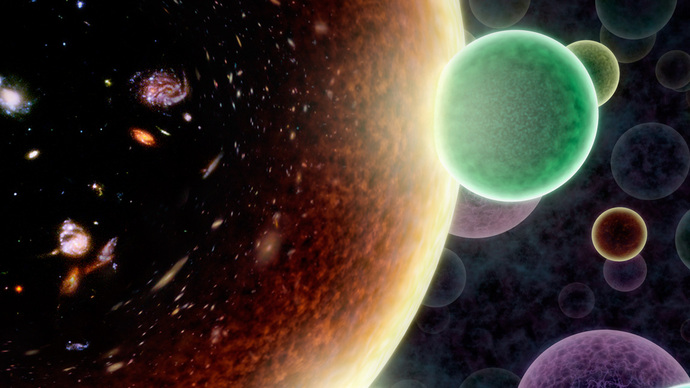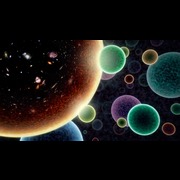Looking Within Our Universe For Something Beyond

Feature • February 22, 2016
Alternate universes are everywhere in science fiction. Captain Kirk swapped places with his parallel-universe counterpart, a malicious version of himself, in an episode of Star Trek. In comic books, superheroes travel back and forth across a variety of different Earths. But do multiple universes really exist? Scientists continue to debate the concept and come up with new theories.
One theory, sometimes referred to as the inflationary multiverse, was recently put to the test. Using data from the Planck satellite, a European Space Agency mission with important NASA participation, researchers looked for imprints of alternate, or "bubble," universes, proposed to have collided with our own in the distant past. The research is still in its infancy, and more testing is needed before any firm conclusions can be drawn.
"Unusual claims like evidence for alternate universes require a very high burden of proof," said Ranga-Ram Chary, an astronomer at NASA's U.S. Planck Data Center at the California Institute of Technology in Pasadena, who has used Planck data to search for evidence of alternate universes.
In the inflationary multiverse theory, our universe is one of many bubbles that pop into existence all the time. Some bubbles inflate wildly, while others collapse back on themselves. Our bubble universe, on the other hand, just happens to have the right amount of matter and other variables to endure and foster the creation of stars and planets -- even life. Like Goldilocks and her ideal bowl of porridge, our universe has just the right traits. How did our universe end up so perfect?
That question is what led to the theory of a multiverse in the first place. If other universes exist, then there are countless opportunities for some of them to end up with the right ingredients to be long-lived and stable.
So how do researchers go about testing for a multiverse? One way to is look for signs within our own universe that another universe beyond has nudged it.
Our universe, on average, is the same everywhere you look. Space missions, including NASA's Wilkinson Microwave Anisotropy Probe (WMAP), and its successor Planck, have produced maps of ancient light in our universe, called the cosmic microwave background, that show our infant universe was remarkably smooth even shortly after its birth.
The leading theory to explain why everything looks the same is called inflation. It says that, moments after the Big Bang, our universe went through a mind-bending, explosive period of growth, stretching apart by a factor of 100 septillion, or 10 to the power of 26, in a minuscule fraction of a second. That stretching smoothed everything out, creating the homogeneity observed in our sky.
It's possible, according to some scientists, that alternate universes could occasionally collide into ours, leaving marks in this otherwise smooth pattern of light. In 2011, researchers used the WMAP data to search for such abnormalities. They specifically looked for unusually bright patches of light in the cosmic microwave background, but they didn't find anything.
Now, years later, the Planck mission has produced new and more detailed maps of our universe's ancient light. Chary explains that Planck observed the sky in nine frequencies of light. Some of those frequencies in the millimeter-wavelength range can pick up light signatures from hydrogen atoms that formed just hundreds of thousands of years after the Big Bang. Thus, researchers using Planck can now search the cosmic microwave background for unusual patches of not just light but also matter.
In a paper to be published in the Astrophysical Journal, Chary reported finding three regions in the sky where the strength of the signal hints at 4,500 times the amount of hydrogen expected. He said it's possible that alternate universes bumped into ours, dumping the extra matter into our universe. But he cautions that more observations are needed before any claims can be made.
Interestingly, Chary didn't initially set out to study alternate universes. He had wanted to understand the glow coming from the early hydrogen atoms and was very surprised when he found the patches of bizarrely dense hydrogen in the data. He says that follow-up observations from ground-based telescopes can help rule out other possibilities for the unexplained patches. There could be contamination from dust or unusual sources of light within our galaxy, which would require observations from other telescopes to rule out.
"Alternate universes are interesting," said Chary, "But to me a more interesting question is: Why is our universe the way it is? For example, nobody knows why we have the amount of matter that we do in our universe. By studying the possibility of alternate universes, we might eventually answer fundamental questions about our own."
As with all science pursuits, there are a lot of unknowns. Researchers ask questions and test their hypotheses, both simple and extraordinary.
"Science is about what you don't know," said Charles Lawrence, the U.S. project scientist for Planck at NASA's Jet Propulsion Laboratory in Pasadena, California. "It took us 13.8 billion years to get to where we are in the universe today, so we can take our time and keep asking questions about all the things we don't understand."
Chary's study in the Astrophysical Journal is online at http://arxiv.org/abs/1510.00126.


